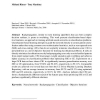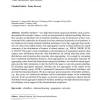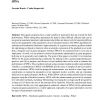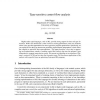ML
2006
ACM
13 years 11 months ago
2006
ACM
Backpropagation, similar to most learning algorithms that can form complex decision surfaces, is prone to overfitting. This work presents classification-based objective functions, ...
ML
2006
ACM
13 years 11 months ago
2006
ACM
We propose a simple approach to combining first-order logic and probabilistic graphical models in a single representation. A Markov logic network (MLN) is a first-order knowledge b...
ML
2006
ACM
13 years 11 months ago
2006
ACM
Abstract Identifier attributes--very high-dimensional categorical attributes such as particular product ids or people's names--rarely are incorporated in statistical modeling....
ML
2006
ACM
13 years 11 months ago
2006
ACM
Most game programs have a large number of parameters that are crucial for their performance. While tuning these parameters by hand is rather difficult, efficient and easy to use ge...
ML
2006
ACM
13 years 11 months ago
2006
ACM
Clustering is the problem of identifying the distribution of patterns and intrinsic correlations in large data sets by partitioning the data points into similarity classes. This p...
ML
2006
ACM
13 years 11 months ago
2006
ACM
Abstract This paper proposes a new tree-based ensemble method for supervised classification and regression problems. It essentially consists of randomizing strongly both attribute ...
ML
2006
ACM
13 years 11 months ago
2006
ACM
In this paper, we describe the syntax and semantics for a probabilistic relational language (PRL). PRL is a recasting of recent work in Probabilistic Relational Models (PRMs) into ...
ML
2006
ACM
13 years 11 months ago
2006
ACM
ML
2006
ACM
13 years 11 months ago
2006
ACM
Bridge bidding is considered to be one of the most difficult problems for game-playing programs. It involves four agents rather than two, including a cooperative agent. In additio...
ML
2006
ACM
13 years 11 months ago
2006
ACM
Higher-order typed languages, such as ML, provide strong support for data and type abn. While such abstraction is often viewed as costing performance, there are situations where i...





